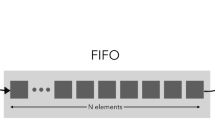Abstract
In this paper we investigate the use of different communication modalities for a multi-robot system. Specifically, the aim is to let a human subject be aware of the goal robots are moving towards: to this end, we compare implicit (i.e., the user infer robots goal from their motion pattern) and explicit (i.e., using visual or audio clues) communication modalities. We propose a user study, performed in virtual reality, aimed to assess which communication modality is the most effective and how they are perceived by human subjects.
While implicit communication has the intrinsic advantage of not requiring any specific hardware on the robots, results of the user study show that implicit communication is comparable, from the users’ perspective, to explicit communication modalities when robots goals are unambiguous and sufficiently distinct. In other cases, explicit communication is preferable.
L. Sabattini—This work was supported by the COLLABORATION Project through the Italian Ministry of Foreign Affairs and International Cooperation.
Access this chapter
Tax calculation will be finalised at checkout
Purchases are for personal use only
Similar content being viewed by others
References
Schranz, M., Umlauft, M., Sende, M., Elmenreich, W.: Swarm robotic behaviors and current applications. Front. Robot. AI 7, 36 (2020)
Lasota, P.A., Fong, T., Shah, J.A., et al.: A survey of methods for safe human-robot interaction. Found. Trends Robot. 5(4), 261–349 (2017)
Dragan, A.D., Lee, K.C.T., Srinivasa, S.S.: Legibility and predictability of robot motion. In: Proceedings of 8th Annual ACM/IEEE International Conference Human-Robot Interaction, pp. 301–308. IEEE Press (2013)
St-Onge, D., Levillain, F., Zibetti, E., Beltrame, G.: Collective expression: how robotic swarms convey information with group motion. Paladyn, J. Behav. Robot. 10(1), 418–435 (2019)
Capelli, B., Villani, V., Secchi, C., Sabattini, L.: Understanding multi-robot systems: on the concept of legibility. In: 2019 IEEE/RSJ International Conference on Intelligent Robots and Systems (IROS), pp. 7355–7361. IEEE (2019)
Capelli, B., Villani, V., Secchi, C., Sabattini, L.: Communication through motion: Legibility of multi-robot systems. In: 2019 International Symposium on Multi-Robot and Multi-Agent Systems (MRS), pp. 126–132. IEEE (2019)
Clair, A.S., Mataric, M.: How robot verbal feedback can improve team performance in human-robot task collaborations. In: Proceedings of 10th Annual ACM/IEEE International Conference Human-Robot Interaction, pp. 213–220. ACM (2015)
Johnson, T., Tang, G., Fletcher, S.R., Webb, P.: Investigating the effects of signal light position on human workload and reaction time in human-robot collaboration tasks. In: Advances in Ergonomics of Manufacturing: Managing the Enterprise of the Future, pp. 207–215. Springer, Cham (2016). https://doi.org/10.1007/978-3-319-41697-7_19
May, A.D., Dondrup, C., Hanheide, M.: Show me your moves! conveying navigation intention of a mobile robot to humans. In: European Conference Mobile Robots (ECMR), pp. 1–6. IEEE (2015)
Szafir, D., Mutlu, B., Fong, T.: Communicating directionality in flying robots. In: Proceedings of 10th Annual ACM/IEEE International Conference Human-Robot Interaction, pp. 19–26. IEEE (2015)
De Graaf, M.M.A., Malle, B.F.: People’s explanations of robot behavior subtly reveal mental state inferences. In: 2019 14th ACM/IEEE International Conference on Human-Robot Interaction (HRI), pp. 239–248. IEEE (2019)
Kim, L.H., Follmer, S.: Generating legible and glanceable swarm robot motion through trajectory, collective behavior, and pre-attentive processing features. ACM Trans. Hum.-Robot Interact. (THRI) 10(3), 1–25 (2021)
Flash, T., Hogan, N.: The coordination of arm movements: an experimentally confirmed mathematical model. J. Neurosci. 5(7), 1688–1703 (1985)
Glasauer, S., Huber, M., Basili, P., Knoll, A., Brandt, T.: Interacting in time and space: investigating human-human and human-robot joint action. In: 19th International Symposium in Robot and Human Interactive Communication, pp. 252–257. IEEE (2010)
Villani, V., Capelli, B., Sabattini, L.: Use of virtual reality for the evaluation of human-robot interaction systems in complex scenarios. In: 2018 27th IEEE International Symposium on Robot and Human Interactive Communication (RO-MAN), pp. 422–427. IEEE (2018)
McHugh, M.L.: The Chi-square test of independence. Biochemia Medica 23(2), 143–149 (2013)
Miller, R.G.: Simultaneous statistical inference. Springer-Verlag New York Inc., (1981). https://doi.org/10.1007/978-1-4613-8122-8
Author information
Authors and Affiliations
Corresponding author
Editor information
Editors and Affiliations
Rights and permissions
Copyright information
© 2024 The Author(s), under exclusive license to Springer Nature Switzerland AG
About this paper
Cite this paper
Villani, V., Vercellino, C., Sabattini, L. (2024). How Can We Understand Multi-Robot Systems? a User Study to Compare Implicit and Explicit Communication Modalities. In: Bourgeois, J., et al. Distributed Autonomous Robotic Systems. DARS 2022. Springer Proceedings in Advanced Robotics, vol 28. Springer, Cham. https://doi.org/10.1007/978-3-031-51497-5_1
Download citation
DOI: https://doi.org/10.1007/978-3-031-51497-5_1
Published:
Publisher Name: Springer, Cham
Print ISBN: 978-3-031-51496-8
Online ISBN: 978-3-031-51497-5
eBook Packages: Intelligent Technologies and RoboticsIntelligent Technologies and Robotics (R0)




